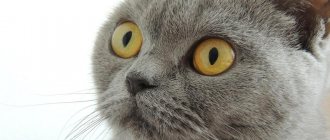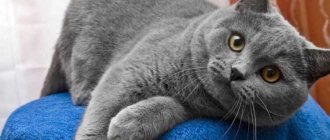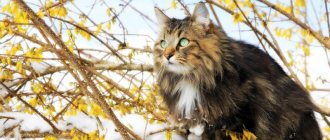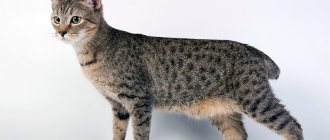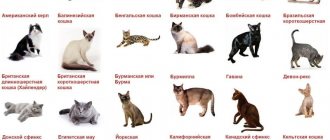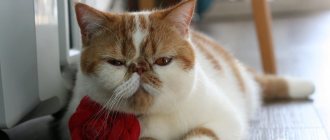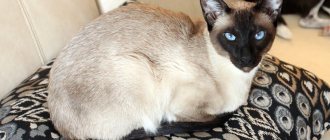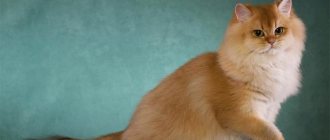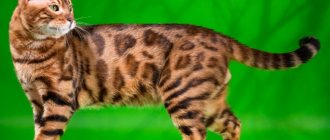Charming chubby dogs with amber button eyes and silky shiny fur, literally of a royal color.
This is how the British Blue breed is described. Below will be a description of the British blue cat with a photo and their character, as well as basic information that you should pay attention to when choosing a pet. The British cat breed, as you might guess from the name, appeared in England as a result of crossing a Persian cat with a domestic English breed. This happened at the beginning of the 19th century, the breed came out to the public at an exhibition in the Crystal Palace.
Peculiarities
The term tabby is usually used to describe patterned colors.
Tabby kittens look very unusual. Several different cat breeds have tabby colors, including British cats. This breed is distinguished by a huge number of different colors. There will never be two identical representatives of the breed, each is unique.
If there is a cat of this breed in the house, in any case the question will arise about the origin of the pet and its color. The symmetrical spots on the coat have clear lines with a distinctive contrasting pattern. The ancestors who passed on this coloring to today's cats lived in the wild in India, Kazakhstan and Africa.
British blue cat behavior
British cats get along well with children and can live well in the company of other animals.
They have no aggression at all and are very friendly. Even if they are not happy with something, cats will not show their claws. British kittens are also very calm when completely alone and the absence of their owner will not cause them to worry. But at the same time, it is a great pleasure for them to be close to their owner, and the kittens always greet them warmly. In their behavior, British cats show how well-mannered they are and will never climb into hands without permission. They are always reserved, although their physical condition allows them to instantly join in any game.
Like any other small animal, a British Fold kitten needs to prepare a place before it arrives in the house. This includes keeping the wires out of sight, because he can easily gnaw them, and hiding all the chemicals that are used in the house.
The kitten also needs to determine a place for him to rest and sleep; you can install a house and a scratching post. Thus, from the very first days you will be able to accustom your cat to order.
When a British Fold comes into your home, you need to give him time to calmly study everything and examine the entire house.
Character
When you look at a white British man, you have an uncontrollable desire to cuddle him. However, the animal itself does not tolerate familiarity. Although kittens do not refuse to play and caress with their owner. Adults do not like to be held. If you pet a British cat while sleeping or when she is busy doing something, the animal will most likely leave or show sharp claws. The owner can only resign himself and caress the pet with his eyes.
The fluffiest cat breeds
Smart cats: breed rating
Fold cat breeds
Owners of white British cats often admit that they do not feel like their owners. This does not mean that animals do not need care and love. They crave attention just like other cat breeds, but they do it in their own way. A curious pet can follow a person on his heels, carefully watching what the owner is doing.
The white British cat is inherently respectable; she will rarely rush around the apartment or jump on the closet. Having accustomed the pet to the scratching post in a timely manner, the owner does not have to worry about the safety of the furniture. These cats are not annoying or mischievous. In general, British cats have an easy-going character. To prevent your pet from turning into a sofa cushion, you need to monitor its weight.
The British meow on rare occasions. As for heat or severe stress (visit to the clinic, traveling by car), some owners do not hear their cat for months. Begging for food is beneath the dignity of white British people. The most the cat will do is cast a reproachful glance towards the owner.
You should not buy a British cat for families with small children. A rare representative of this breed favors children. Children are too clingy and noisy, which can turn a cat’s life into constant stress and the search for a secluded place to sleep. The British do not like long games and persistent petting. It will be difficult to explain to children that this plush miracle is inviolable.
What to feed them
British cats are prone to obesity, which should not be allowed. Excess weight and a sedentary lifestyle will lead to poor health of animals and the development of diseases. You should not accustom them to flour and sweets, give them food from the table and allow them to beg.
The diet may consist of dry food or food prepared by you. When choosing dry food, strictly follow the instructions for choosing the amount of food. Remember, the package indicates the amount of food per day. Choose your own food for each age. The packaging indicates two numbers for the consumption rate in grams.
The first number is the amount of food for sedentary and inactive cats, the second number, on the contrary, is for active cats who walk outside for at least 3 hours. Do not mix dry food with table feeding. The fact is that dry food is made taking into account the correct balance in daily nutrition, with the addition of vitamins, nutrients, etc. If you overfeed your cat, the excess will be deposited in the form of fat on the animal’s ribs or stones will form in the genitourinary system.
When compiling your own diet, determining the daily intake will be somewhat more difficult. When developing a menu, consider the following characteristics of your pet: age, activity level, living conditions and weight. If you have a kitten, you need to feed it 2 times more often and more than a cat over 3 years old. A kitten can be compared to a small child who needs a lot of vitamins and high-calorie food, since a lot of energy is spent on its development and during play. Therefore, nothing is deposited on the ribs.
With an active lifestyle, the animal needs a lot of vitamins and nutrients consumed throughout the day. Also, the daily consumption rate should be higher than usual if the cat does not live at home during the winter, near the radiator, but in an unheated room.
Check your pet regularly for signs of excess weight. First of all, check for the presence of fat on the lower abdomen, between the hind legs. Secondly, feel the ribs. You should start worrying about the problem of obesity if you feel a fatty layer on the ribs. Another way to determine body fat is when the animal's body has acquired a square shape.
To solve the problem of obesity, gradually reduce the amount of food you eat. Cats eating dry food need to reduce the daily intake to 3-4 times over 1-2 weeks. At the same time, monitor its condition and appearance. The main thing is not to overdo it. Go see a veterinarian. He will advise what to feed a British breed cat to treat obesity. In veterinary stores you can buy special low-calorie food for the “diet” period. They will not allow the fat layer to accumulate without reducing the volume of feed given.
When creating your own diet, exclude fatty, sweet, flour products such as semolina, pasta, millet cereals, etc. Include lean beef, vegetables, dairy products and low-calorie cereals such as oatmeal, millet and corn chaff in your diet. The volume of previously consumed food is reduced to 2 times. The ideal option is a combination of diet and exercise.
Caring for a Blue Briton
Animal care should be carried out in several directions:
- The British coat is combed with special brushes with metal or rubber bristles that are not rough and do not damage the skin. Kittens should be taught to brush themselves from a young age - then the animal will definitely begin to treat the procedure patiently and even accept it with gratitude. Particular attention should be paid to this during the cat’s molting period - this will additionally avoid the spread of hair on carpets and upholstery and help speed up this process. Remains of fur after the procedure can be removed with wet hands or a special rubber glove. But bathing is a completely optional procedure for an animal, but if your youngest family member manages to get very dirty, then just wash him under running warm water with a special shampoo.
- Kittens and adult animals may have discharge around their eyes, which can be simply removed with a cotton swab and eye wash solution, but keep in mind that the appearance of purulent discharge is a signal that the animal urgently needs to be examined by a veterinarian
- The auricle of a healthy animal is uniform in color, clean, and odorless. If you have a problem cleaning the ear, just use a cotton swab soaked in the solution intended for this, but do not be zealous to prevent any foreign objects from getting into the ear canal.
In general, the breed has good and stable immunity and is not susceptible to special diseases with proper care, just do not forget to look closely at your pet and changes in its behavior and character, because if your cat gets sick, he will definitely try to tell you about his illness in the only way available to him language - behavior.
Making the right menu for your pet
Below is a description of how to feed a British cat. The growing body of small kittens up to 1.5-2 months requires food up to five times a day; an older pet, up to six months, is offered food three times a day. As your pet gets older, you need to be taught to eat twice a day, as an adult animal should.
Of course, in between feedings, you can treat the animal with its favorite “snack” as a reward. However, overfeeding a cat leads to obesity and a reduction in its lifespan.
It makes sense to give blue Britons vitamins, preferably in courses, which your veterinarian or consultant at a specialized pet store will help you choose.
The kitten can be fed with ready-made food, natural products, or a combination of both:
- Feeding with special prepared foods. There are many ready-made foods for cats and kittens that you can offer your pet. It is worth choosing from well-known companies of special food for cats; in no case should you give preference to advertised food like Whiskas - such food contains many harmful additives, and the main component - protein - is made from dubious products, such as skins and bones of carcasses.
- Feeding with natural food. If you decide to feed your British cat “natural” products, then first of all remind yourself that a cat is a carnivorous animal, and therefore it has every right not to eat your “that delicious soup.” Try to give your predator foods rich in animal proteins. Meat and offal must be frozen. Food should be at room temperature and always unsalted. Do not add too much fish to your diet, as this can lead to urolithiasis and kidney disease. It is better to completely remove fish from the diet of castrated cats.
- Complex feeding. You can also treat your pet to a complex diet, using dry food as a basis, and natural meat or fish products as an additional supplement.
Sorry, there are no surveys available at this time.
And remember: the best thing you can give your pet is care and love!
Care
Another point in favor of the fact that British Shorthair cats for business people is their ease of care. All you have to do is brush your pet, preferably once or twice a day. The hairs fall out and, due to the dense fur, get stuck there, causing discomfort to the animal.
During shedding, you can comb it several times a day, it won’t be unnecessary. Moreover, this process will only be a joy for the cat, and after some time he himself will run to you when he sees the brush. It is best to choose a soft bristle or rubber brush.
But this also has a negative impact because animals often swallow hairballs during brushing. This can cause indigestion, so veterinarians advise periodically giving special medications that dissolve the fur.
Pros and cons of the British cat breed
| Positive traits | Negative qualities |
| Unusual appearance | Tendency to genetic diseases |
| Sociability and loyalty to all family members | Ears require special care |
| Good learning ability | |
| Resistance to common diseases |
Experts believe that it is already possible to detect the presence of genetic diseases in a British Fold cat at the age of 3-5 months. In addition, conscientious breeders adhere to recommendations regarding mating in order to improve and strengthen the breed.
In such conditions, the risk of developing pathologies is reduced to a minimum, which means that the risk of acquiring a sick animal is significantly reduced. A healthy and cheerful fold-eared cat is always joy and good mood for its owner.
British blue cat nutrition
Like any other pet, a balanced diet is important for the British pet, which will help him ensure longevity, an active lifestyle and, of course, health.
You need to be prepared for the fact that cats of this breed are very picky eaters. They cannot digest spicy, salty and fatty foods. Food from the refrigerator is also dangerous for them, so before giving it to your pet, you need to heat the food to 26 degrees. The most important thing in a cat's food is lean meat . A Briton can eat meat either boiled or raw. It is preferable to feed your cat raw meat, as it contains more vitamins and promotes jaw development. When it comes to poultry, the British prefer to eat chicken that has previously been heat-treated and the meat has been separated from the bones.
It is also necessary to include plant foods in the cat’s diet. These include cereals, vegetables, and herbs. Of these, she prefers zucchini, carrots, cucumbers and even cabbage. Don’t forget about dairy products – sour cream, yoghurts, cheeses. Cheese for a kitten, of course, is better to choose only lightly salted varieties.
For vitamin supplementation, you can purchase seeds of a special vitamin-rich grass at a pet store and plant it at home.
STORY
Already from the name it is clear that the British cat breed came to us from England. The first representatives of the breed began to be bred at the end of the 19th century by crossing Persians with English domestic cats. The first British blue cat was shown at an exhibition held at London's Crystal Palace. She made an indelible impression on the public of that time.
Almost immediately, the breed of British cats was officially recognized and became very popular in England. Gradually, the British began to be taken to other Asian and European countries.
It is worth noting that the 130-year history of the British cat breed has seen its ups and downs. It is known that the population suffered greatly during the Second World War. But through the efforts of breeders, the breed was restored.
Now British cats of noble blue color are very popular in Russia.
By the way, they were brought to our country only in the middle of the 20th century. The average life expectancy can reach 12-15 years with proper care and feeding.
Video: Description of the breed
https://youtube.com/watch?v=L7KJfTyH8Dk
Blue cat
A true British Blue cat has soft, fluffy fur and is somewhat reminiscent of a teddy bear. Distinctive features include huge round eyes of amber, copper or orange color and soft short or long fur of an even gray-bluish color. In purebred cats, the hairs are colored from the base to the very tips. Often spots and impurities in color can cause culling.
The British have a powerful, strong and muscular body of medium size. Males are larger in size than cats. The legs of the British are short and dense with rounded soft paws. The tail is thick and not fluffy.
A fairly massive round head, a wide chest, a short and strong neck, wide and slightly rounded ears, very dense hair, a short and straight nose - these are the main characteristics of the appearance of the British Blue cat. Fold-eared representatives of this breed have ears tightly pressed to the head. The appearance of such cats looks especially cute and touching.
Adsense clicker for making money on Google AdSense from 500 to 1000 dollars per month
We will learn about the treatment of ringworm in cats, discuss interesting information. We will tell you about the description of the Russian Blue cat breed: https://tvoipitomec.com/cats/porodi/russkaya-golubaya-koshka-opisanie-porodyi.html, find out the details.
British Blue cats have excellent health and are one of the natural breeds.
In addition to short-haired blue British cats, there are also long-haired ones. But in Russia they are not so common. The average weight of a representative of this breed ranges from 4 to 6 kg.
British shorthair cat? Description of the breed and character of the blue English cat
The British shorthaired beauty is ideal for a business person who does not have time to pay much attention to his pet, and for an old man who values peace and comfort.
The cat with a touching round muzzle and soft velvet fur has a calm, phlegmatic and independent character, is not afraid of loneliness, and behaves with dignity and aristocratically.
British shorthair cat
The British cat is one of the oldest existing breeds. It is also called “blue” for its classic bluish-silver color, and also “short-haired” for its soft, pleasant-to-touch coat.
British pets are distinguished by a strong body, good immunity, but are capricious in care and maintenance.
History of the breed
There are two versions of the origin of the English cat breed.
According to the first version, the “British” descended from their French counterparts - representatives of the Chartreuse breed. These cats were brought to Europe from Africa.
At first, the “French” were bred by monks. Then sailors began to use Chartreux, taking them on ships as rat catchers. On ships, French cats arrived in England, where they became the founders of the British breed.
According to the second version, the history of British shorthair cats dates back to the time of the Roman conquest of the British Isles. Roman legionnaires brought cats with them. The animals quickly got used to the new territory. The locals liked the cats because they were great at catching mice.
INTERESTING! The second version is considered more reliable, since many large burials of cats from the Roman period have been found in Great Britain.
Breed standard
British Shorthair cats have a large, massive body. Males weigh 6–9 kg, females weigh significantly less – 3.5–6.5 kg. Representatives of the breed grow up to 5 years.
Detailed breed standard of a British cat, description of appearance:
- The head is large and rounded. The cheeks are plump. The forehead is convex, smooth between the ears. The depression between the forehead and nose is not pronounced.
- The eyes are round, large, and widely spaced. The color of the iris is determined by its color; it can be deep yellow, copper-yellow, blue, green. White individuals often exhibit heterochromia.
- The nose is straight and short.
- The ears are medium in size, with a wide base and slightly rounded tips. Set low on the head.
- The neck is short, inconspicuous, with well-developed muscles.
- The body is strong and muscular. The physique is harmonious. The chest is voluminous and wide. The back is short, with developed muscles.
- Limbs are short and strong. The paws are rounded, neat, the toes fit tightly to each other.
- The tail is thick, of medium length, wider at the base, with a rounded tip.
- The coat is short, shiny, and pleasant to the touch. The undercoat is voluminous and dense.
Color options
At first, the predominant color of the British cat was blue. The result of long-term selection work was the appearance of more than a hundred colors, combined into the following types:
- single-color - the hairs are painted in one color (blue, silver-blue, silver, black);
- smoky - the undercoat is light, and the tips of the guard hairs are dark, the eye color is predominantly copper;
- bicolor - two-color cats, the color of which combines white and primary colors;
- tortoiseshell – the color is represented by a combination of two or three colors scattered throughout the coat in chaotic spots;
- tabby - “wild” color, implying the presence of a marbled, striped or spotted pattern, the forehead is required
- decorated with a pattern similar to the letter “M”;
- point (“Siamese” color) – some parts of the body (muzzle, tail, paws) have a darker color.
Character
This cute fluffy British kitten just wants to be cuddled. But British cats do not tolerate being cuddled. If a growing kitten still retains playfulness and a desire to be caressed, then an adult English pet is not particularly willing to even sit in one’s arms, let alone caress.
Blue British are real aristocrats, they are the masters of the house, and people are just servants. But independence does not mean a lack of love for a person, the cat simply expresses feelings in a different way: it is next to the owner, watching his household chores.
British cats are respectable, phlegmatic, balanced, they do not play around, do not damage furniture, and do not knock over things or flower pots.
INTERESTING! The “British” are so calm that they hardly meow. Owners do not hear the voices of their pets for weeks.
If there is a small child in the family, it is not worth it, the cat does not like noisy children's company, and gets irritated when children squeeze him. Also, British pets do not get along well with other animals if they are distinguished by active behavior and lively disposition. For example, it is absolutely forbidden to introduce a “British” dog to a husky.
and care
The luxurious fur coat of British Shorthair cats is easy to care for. Dense velvet wool almost does not pill. Scratching your pet twice a week is enough to remove dead hair. But during the molting period, combing should be daily.
The ears are cleaned once every 2 weeks. The teardrops in the eyes are wiped with a cotton swab moistened with warm water once a week.
ATTENTION! It is advisable to periodically give your cat a hair remover. When an animal licks itself, it swallows a lot of hairs, and they can cause disturbances in the functioning of the stomach.
You shouldn't bathe your British pet often. Bathing with the use of zoo shampoo for soft-haired cats is done only when the fur is very dirty.
A cat can be walked on the street, but in urban areas only on a leash, so that the pet does not become a victim of dogs, cars and bad people. The cat is only taken out for walks in warm weather.
Feeding
British cats are fed either prepared premium food or natural food. You cannot combine natural food and store-bought food.
If you choose natural food, then the diet includes:
- lean boiled meat;
- poultry without bones;
- cereal porridges (rice, millet, oatmeal);
- boiled vegetables (carrots, zucchini);
- boiled eggs;
- fermented milk products.
You should not give your cat fatty meat, sausages, smoked meats, baked goods, or sweets.
There should always be clean drinking water in your cat's bowl.
Features of the body
In general, British shorthaired pets are distinguished by good health and live up to 13–17 years. A mature British cat is less active than kittens.
IMPORTANT! “The British” love to eat, so the most common disease in pets is obesity.
There are no breed-specific diseases in British shorthair cats, but pets can get sick with pathologies typical of all cats. This:
- hypertrophic cardiomyopathy - a violation of the heart rhythm due to thickening of the ventricle, if untreated, leads to the death of the cat;
- hemophilia B-type – low blood clotting, caused by the manifestation of the disease gene as a result of inbreeding;
- renal polycystic disease - the formation of multiple cysts that impair the functioning of the kidneys; the British Shorthair received the gene for this incurable disease from a Persian cat as a result of hybridization;
- Gingivitis is an inflammatory process in the jaws, leading to tooth loss and blood poisoning.
It is strictly forbidden to remove a pet's claws; this can lead to arthrosis and other bone defects. It is better to use a nail clipper to trim the ends, and also to accustom the animal to the scratching post.
Price
The British Blue cat is an elite breed that cannot be cheap. If the seller offers a kitten at a low price, it means that it is not purebred or sick. For a purebred British kitten, breeders ask from 25 to 40 thousand rubles.
Russian nurseries
You cannot buy a British kitten at a pet store or from someone else. Breeders and nurseries sell purebred kittens.
In Russia, the British Shorthair cat breed is bred in the following nurseries:
- "Galeksy" (Vladivostok);
- "Brit Favorite" (Moscow); "Regina Margot" (Krasnodar);
- "Ariosto" (St. Petersburg).
The breeder must provide the buyer with documentary information on the pedigree and a veterinary passport.
Owner reviews
- “We call our Winston “Cheshire.” Look for a slower and more imposing cat. He can sit for a long time, watch what we are doing, where we are going. The muzzle is thick and always smiling, just like that cat from the fairy tale about Alice. Delicate, doesn't drag food off the table, doesn't ruin curtains. If he wants to eat, he will sit near the bowl and silently look at you with a pitiful gaze. He doesn’t particularly like to go for walks; if you carry him out, he’ll sit on the grass and sit there for the entire walk.”
- “My Oswald is an example of feline aristocracy. I cut his nails, comb his nails, bathe him - he doesn't even make a squeak. In general, he rarely meows, but he purrs loudly when he is happy. He doesn’t like to be held in his arms, but he accompanies me to work every morning. He pets whenever he wants, and this rarely happens. But if he wants, he won’t leave until you pet him.”
- “I love my blue handsome boy. Although his character is unbearable. You can’t pick him up, you can’t sit him on your lap, he only sleeps on the sofa, he only eats Royal Canin, you call him - he’s silent. With all his appearance he shows that he doesn’t need you.”
British smoothhair
The smooth-haired "British" is a type of breed that Europeans call "Highlanders" and Americans call "Lowlanders."
The breed variety was recognized only in 2008. Before this, smooth-haired kittens were recognized as pets.
A special feature in the description of the breed is medium-length wool with dry guard hairs, often lengthening from the neck to the tail.
British plush
A classic variety with soft, short, pleasant-to-touch coat. British shorthair cats have guard hairs and undercoat of equal length, not exceeding 2.5 cm. Moreover, the undercoat is voluminous and dense.
Pros and cons of the breed
Advantages of British Shorthair cats:
- piercing intelligent look;
- gracefulness of movements;
- strong immunity;
- lack of aggression;
- cleanliness;
- the ability to treat the owner from nervous and emotional problems.
Disadvantages of the breed:
- capriciousness, independence, willfulness;
- the need for careful and regular care;
- the need to control diet to prevent obesity in your pet.
The British Shorthair is an aristocrat in the cat community. She is unobtrusive, but responsive to care and affection. This is an ideal pet for a person who values harmony, comfort, and a relaxing pastime.
Did you like the article?
Description of the breed
The blue British shorthair cat is one of the most popular cats in Russia at the moment. It’s very simple to answer the question “why”, just look at the photo: a large body with powerful paws, short fur of an amazing color with a thick undercoat, a regular shaped head with round large eyes of yellow shades, plush cheeks and... a smile!
Yes, it is the special structure of the faces of these aristocratic cats that creates the illusion of a friendly smile, for which they are quite justifiably compared to the Cheshire Cat from the famous Disney cartoon.
It is worth noting that two different breeds should not be confused: the British Shorthair and the Scottish Fold. A blue fold cat has quite a lot in common with a cat of the British breed, and the kittens of these breeds in the photo are very similar, but generalizing them is quite a big misconception.
If you decide to choose a blue British Shorthair kitten, then you should contact well-known nurseries in your city that specialize in breeding this breed. There you can carefully examine the kittens: touch, stroke and observe the behavior of the future pet.
First of all, the kitten must be at least 12 weeks old and have clean, plush fur, skin without damage, and mucous membranes of the eyes without swelling or redness. The animal should be playful and inquisitive; lethargy and apathy are, on the contrary, a bad sign.
- Exhibition kittens are classified as Show - this means that the appearance and character of the cat must ideally correspond to the standards of the breed. Such animals must easily endure travel, large crowds of people, and be able to show themselves and their character at exhibitions without embarrassment or timidity.
- The Breed category includes kittens for which their pedigree is very important, because animals of this class are bred for subsequent breeding. They can also participate in exhibitions, but their main criterion should be the ability to pass on the best breed qualities from generation to generation.
- The Peet category is assigned to the British "domestic type". Such animals may have minor defects or abnormalities, or may be too shy to be shown or posed for photographs. Of course, the presence of defects in this category is not at all necessary, but they do occur. However, the criterion for these animals is ideal adaptability to keeping a home, without losing the basic qualities of the breed.
Of course, the most important thing is that a purebred British Blue kitten must have a veterinary passport with vaccinations and a full description of the pedigree, and its breeder must have a certificate or other document confirming experience in breeding.
Origin of color
The first British cat of Blue color appeared in 1871 and took first place at a cat show. The cat was introduced by breeder Harrison Ware. The appearance of the Briton charmed fans, but only in 1950 did she gain recognition in American felinology.
For over a hundred years, breeders have worked to achieve the perfect standard of the British Blue. To achieve the result, they were mated with various breeds of cats: Persian, French, and blue Russian cat. It has been established that the recessive Blue tone is a diluted black pigment. Therefore, the color varies over a wide spectrum from dark graphite to light gray, rich blue. Now certain standards have been established for the color of the breed; according to color, it is rated up to 25 points.
Breeders have difficulties with breeding; according to the rules of genetics, this is a recessive color and two Blue parents can produce the same kittens of both sexes. When mating with other colors, it is difficult to get blue kittens.
Eyes
Not only the beautiful, soft, shiny coat evokes admiration, but also the charming, large, round eyes. They are widely spaced relative to the nose, which gives them more expressiveness. The coat color of a British cat looks good in the photo in combination with their eyes, which are copper, orange, and golden.
Due to the yellow color of the eyes and the gray-blue color of the coat, the pure British cat is sometimes confused with a mixed breed from a Russian cat, but they are distinguished by the shape of the head and the full cheeks characteristic of the blue solid.
Varieties
Drawing
There are several subspecies of British cat colors with certain standards:
- striped, also called brindle;
- spotted, also called leopard print;
- ticked;
- marble.
Striped
The brindle color of the British cat, or the tabby color pattern, is the most common. This color is the most common. A distinctive feature is that the main color of the coloring runs along the cat’s spine. The main requirements of this type are a surprisingly clear and dense drawing of the pattern. Like other types of coloring, a mark in the form of the letter “M” is drawn on the animal’s face.
Marble
This coloring is very beautiful and unusual, the marble color shade of the drawn pattern is unique. The drawing is not interrupted or intersected. A fancy pattern in the form of a butterfly is drawn on the back of the head. The characteristic letter “M” is located on the nose. A distinctive feature is the necklace that forms on the chest of the animal.
Ticked
With this type of color, it may seem that the coat has a single color, but this is only at first glance.
The coloring differs in that the part of the fur that forms the top coat resembles a layer of “dust.” The lower part of the undercoat has a color similar to the upper coat. It can be blue, chocolate, black, or other colors.
In addition to the design, color options also differ.
Color
Brown tabby
British brown tabby cats have an amazing color throughout their body. Very black color, reminiscent of coal soot. The nose has a slightly red tint and is lined with eyeliner. A distinctive feature is the spotted tail of the animal.
Black silver
The background part of the fur has the most delicate blue color. The pads on the animal's paws are colored pink or blue. The patterns that are located throughout the body are painted in a silver shade.
Mixed
The above colors can also be combined with the white color of the animal's coat. They differ in that they have approximately the same amount of tabby and white colored coats. If tabby patterns are found only on the head and tail of the animal, and the rest of the color is white, then this type of color is usually classified as a “van” type.
There are a great variety of colors that can be listed endlessly, among them such famous ones as the lilac color, which is distinguished by its rarity. A varied, detailed description will allow you to choose what the buyer needs. The gray color, quite popular in England, is also in demand.
Character and behavior of shorthaired lilac British
The influence of coat color on the behavior of an animal has not been studied enough, but some practical observations are known that allow us to draw conclusions about the presence of such connections. White cats, as a rule, are docile, and black cats are obstinate, striped tabbies tend to hunt wildly, and color-point cats are secretive and even treacherous.
The character of lilac cats is within the behavioral instincts of their breed, but leans towards a more loyal view of owners and family members. Typical British Shorthairs are reserved and often seek solitude.
Cats show indifference to other pets, and in case of conflict they prefer to retire to a safe place.
Against the general psychological background of their breed, lilac-colored Britons demonstrate more softness and even delicacy. The nature of these cats does not have the habit of active games, but the lilac ones are ready to take part in general fun and can even sit for a short time in the arms of the owner.
The history of the appearance of true British colors
The main role in the formation of new colors in cats belongs to genetics. The first cats bred without any rules, since the survival of the species was the main goal. But when the cat became a pet and settled next to a person, the situation changed dramatically.
The owners wanted to make some parameters more predictable in order to get kittens with a certain coat color.
The gray-blue shade has been recognized as the main color for British Shorthair cats. The further evolution of colors began with him. The main achievements of the debut period are attributed to the English artist Harrison Weir, a great lover of British cats and a specialist who compiled the first standard of this breed.
During the selection, a line of solid colors was fixed, where, in addition to the main one (often called British), a palette of white, black, blue, cream, chocolate and red appeared. And at the end of the twentieth century, a purple tint was added to them.
CHARACTER
If you decide to get a British Blue cat, get ready to interact with a friendly and affectionate pet. Representatives of this breed are distinguished by their good manners, restraint and balance.
But at the same time, the British are extremely active and love to play. That's why children are especially delighted with them. Blue British cats are extremely curious and restless. They are very interested in the world around them.
Calm comes to these representatives of the animal world over the years. They become more important and sedate. The truth here is that much depends on the psychological situation in the master’s house.
Video: main features of this breed
Even blue British kittens can grow up nervous if they have aggressive owners. Unlike other breeds, Britons are extremely sensitive to people's behavior.
The character of blue British cats is finally formed by the age of three. Clean and well-mannered representatives of the breed are usually distinguished by their friendliness towards all members of the household.
They will never bite or scratch for no apparent reason. Blue British people treat other pets quite calmly. But new people cause some wariness in cats.
This is not to say that they are subject to training, but to teach cats to go to the litter box and sharpen their claws in a certain place. In the character of British cats one can notice the manifestation of leadership qualities. Animals also do not tolerate confined spaces. For example, they are extremely irritated by closed doors.
Representatives of the described breed should not be handled, as they really do not like it. But you can pet the British as much as you like.
Scientists have proven that the unusual gray-blue color has an extremely positive effect on the cardiovascular system of the human body.
We will tell you about the symptoms of lichen in cats, find out the details. Read about the character of the Bengal cat. What are the features?
Good tips, here you will learn about the description of the Neva Masquerade cat breed.
An interesting distinctive feature of the British blue cat's character is its pride. A purebred pet will never respond to the primitive “kiss-kiss”, but only to an affectionate nickname. If you forget to feed your British Blue, he won't ask for food. Rather, the cat will sit near the bowl and look intently at you.
Also, representatives of this breed can be wayward and aggressive if their owners treat them carelessly and rudely. Smart, independent, reserved and aristocratic - this is how you can characterize British blue cats.
Features of behavior
So, you got a mischievous little blue British kitten and are already prepared to bear retribution for the fact that he so easily won you over with his smile. It is absolutely correct to expect various pranks from a new family member, because kittens of any breed and any color up to six to seven months, and sometimes up to a year, behave in the same childish way. However, as you grow up, your pet will surprise you with its waywardness, restraint and independence.
Compassionate owners should not be afraid that their pet will get bored and sad while they are at work. British shorthair cats will not destroy the apartment in your absence, no, they will not hang on the curtains, because there are much more pleasant things, for example, sleep.
Character
It is worth paying tribute to the character of this ancient breed, the oldest, since the description of the British blue color existed back in 1750. Unobtrusive, but not indifferent, capricious, but non-aggressive - such animals would rather avoid conflict than use their claws and teeth. But you shouldn’t impose and persistently try to sit him on your lap, just give him freedom of choice and he will gratefully lie down next to you and unquestioningly allow you to pet him and scratch him.
The British Shorthair cat will always become the dominant animal among others, rest assured that he will not only get along with your other animals, but will definitely take precedence over them, because by nature your blue British cat is a true leader!
However, who is the boss of the house? Of course you! Therefore, it is necessary to raise an animal from childhood, and since British cats are distinguished by high intelligence, when purchased from experienced breeders, they are already accustomed to observing the rules of personal hygiene.
Conclusions about the breed
The British are often called Cheshire. Big eyes and a semblance of a smile on his round face make him look like this famous character. Although perhaps it was they who served as the prototype for the legendary fairy-tale cat. This once again proves that the British Shorthair is not just an ordinary member of the cat fraternity. She is a historical and legendary creature on Earth.
Over time, plush kittens turn into noble, sedate and majestic cats, deserving a place on the virtual throne among all domestic four-legged animals.
People's sympathy for short-haired pets from Britain does not require proof. It is unconditional and limitless. And the great thing is that this love is mutual. The British cat went through considerable trials, but its representatives faithfully and devotedly remained close to humans. To this day, they continue to decorate homes with their presence, giving adults and children a lot of positive emotions.
Easy care, excellent character and healthy genetics are excellent reasons for owning a handsome thoroughbred.
Kitten toilet
In this matter you need to be persistent and patient .
The kitten needs to choose the most secluded place, for example, a bathroom or toilet. It is important that the toilet is not located near the place where the cat rests and eats. In the tray, which is selected according to the size of the cat, you need to pour a few centimeters of litter for toilets. It must be replaced frequently as it is used. It is better to wash the tray using baby soap and a sponge. If a small pet cannot immediately get used to the tray, under no circumstances should you shout or scold him. You need to put the tray in the place where it “shits” and gradually move the tray closer to the place that you have allocated for it.
The British Fold kitten does not require much hassle in keeping and caring for itself. And if you follow the simple rules of keeping it, the kitten will be active, healthy and will bring a lot of positive emotions to its owner.
British fold kittens

